How to breed larva
How to get eggs and larva from adult stag beetles is almost the same way as described in “How to care adult stag beetles“, but there are some additional tips.
Things to prepare
Oak wood that is around 10 cm in diameter (photo on the left: 10 cm in diameter, photo on the right: 30 cm in diameter).


Setting up
Dip the oak wood into water for 12 hours. Then take the wood off from the water and put it in a shade for another 12 hours. This procedure makes the wood appropriate conditions for egg laying. Then put the wood into the wood flake.
Only one pair of male and female should live in a single case. One female, without male, would also be enough for laying eggs if you got her in nature.
If you care them as the same way as “How to care adult stag beetles”, the female will make holes into the wood and lay eggs. Once you found holls have been digged, you should separate the male to another case so that you can avoid battles between the male and the female. Two weeks after you found the holes, you should separate the female to another case.
Two to three month after you found the hole, you can try to pick larva from the wood. Use a minus driver or a knife to split the wood carefully to find larva. Be careful not to hurt yourself.
You should look also for the wood flake because larva could be there.
Breeding larva
Larva should be separated each other and placed into bottles. You can fill wet wood flake tightly in the bottle. The bottle size would be, for example, 200-1,000 ml (The bottle and the flake can be replaced according to the growing conditions). If you put the larva on it, he/she will dig into the flake by themselves.
2 thoughts on “How to breed larva”
Why is mating taking a long time?
Hi Jarome, I did not have an answer to your question, so I searched on Google scholar shortly. I found an article that describes mating time of Dynastes hercules paschoali as 30 to 85 min (Lai, J. (2011). SCARABS. SOLA, 13.). You are correct that mating takes time. I also found another article that describes longer mating time increases quantity of sperm transmitted in Armadillidium vulgare (Lefebvre, François, et al. “Mass drives mating success in Armadillidium vulgare (Crustacea, Oniscidea).” Behavioural processes 168 (2019): 103944.). Both articles are not about stag beetle, but if I speculate from these two, longer mating time leads successful reproduction also in stag beetles.